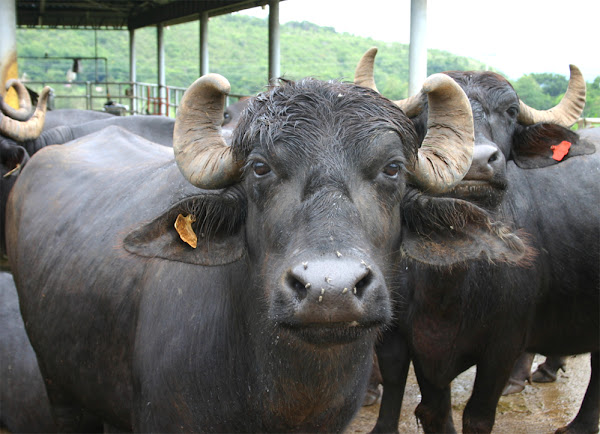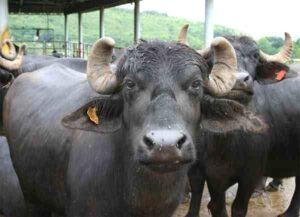Buffalo farming is a traditional business in many countries around the world. Wild water buffaloes were domesticated in the Indian subcontinent about 5000 years ago, and about 4000 years ago in China.
There are two types of water buffaloes which are raised by the farmers. These two types are recognized based on morphological and behavioral criteria. These recognized two types are the river buffalo and the swamp buffalo.
The river buffaloes are found in the Indian subcontinent and further west to the Balkans and Italy. And the swamp buffaloes are found from Assam in the west through Southeast Asia to the Yangtze valley of China in the east.
The river buffaloes which are present today are the result of complex domestication processes involving more than one maternal lineage and a significant maternal gene flow from wild populations after the initial domestication events.
Buffalo farming is very important for some people in the Indian subcontinent, especially India. There are currently at least 130 million domestic buffaloes exist throughout the world, and more than 95.8 percent of this population are found in Asia.
Total buffalo population in India is over 97.9 million head in 2003, representing 56.5 percent of the world population. People in India and some other Asian countries depend on buffalo farming than on raising any other domestic animal.
The buffaloes are especially very suitable for tilling rice fields, and their milk is richer in fat and protein than that of dairy cattle. However, read more information about this business.
What Is The Importance Of Buffalo Farming Business?
The buffaloes are actually ideal animals for working in the deep mud of paddy fields because they have large hooves and flexible foot joints.
They are often referred to as ‘the living tractor of the East‘. It is probablys possible to plough deeper with buffalo than with either oxen or horses.
They are the most efficient and economical means of cultivation of small fields. But after modernization of agriculture, uses of buffaloes reduced dramatically. And currently the buffaloes are raised either for milk or for meat.

How to Start Buffalo Farming Business?
Starting buffalo farming business is just like starting cattle farming business. But the exact husbandry system depends on the purpose for which they are bred and maintained.
However, here we are describing about the steps for starting buffalo farming business. Hope this guide will help you.
Step 1: Gather Practical Knowledge
First of all, try to gather practical knowledge about this business. Learning practically is very important for starting and operating a successful buffalo farm. You can visit some farms in your area for having practical knowledge.
Step 2: Complete A Training
Buffalo farming is a lucrative business, but it requires specialized knowledge and skills to be successful. That’s why completing a training is very important for maintaining a successful farm..
There are several options available to choose from for completing a buffalo farming training. You can complete the training from any o your local agricultural extension offices, universities and colleges, private training providers, and industry associations.
Step 3: Make An Effective Business Plan
Making a good and effective buffalo farming business plan is very important. A good business plan provides a roadmap for success and helps to identify potential challenges and opportunities. So, make an effective business plan and try to include everything in the plan such as the executive summary, business description, market analysis, marketing strategy, operations plan, and financial plan. You can ask for help from an expert if you are a beginner.
Step 4: Select A Suitable Location for Your Buffalo Farm
Choosing the right location for a buffalo farming business is also very important. The farm location can impact various factors such as animal health, productivity, and profitability. So, try to select a very good location with all required facilities.
Some important factors to consider when selecting a location include climate and weather conditions, availability of water, access to grazing land, proximity to markets, availability of labor, and biosecurity.
Step 5: Determine Your Purpose
Buffaloes are good for many different purposes. So, determine the purpose and make it clear ‘why you want to raise buffaloes’. Common purpose for raising buffaloes are meat, milk, working animal, leather, fertilizer, bones, and horns.
Step 6: Choose Best Buffalo Breeds
Success in buffalo farming business also depend on selecting good quality breeds. So, try to select very good quality breeds depending on your production purpose. Some breeds are good for producing meat or milk, and some are good for other agricultural purposes.
Some well known and popular buffalo breeds are Murrah, Surti, Jafarabadi, Anatolian, Nili-Ravi, Egyptian, Mediterranean, Pandharpuri, Nagpuri, Bhadawari and Romanian buffalo. Select and purchase buffalo breeds depending on the availability in your area.
Step 7: Purchase Good Quality Buffaloes
Buying the right buffalo is essential for the success of your business. It’s always better to purchase the animals from local suppliers or breeders. Try to purchase healthy and active animals.
Step 8: Provide Good Housing
The buffaloes don’t have special requirement in terms of housing. They will be fine and stay happy if you can arrange basic requirements for them.
Just like domestic cattle, around or up to 40 square feet housing space will be enough for each buffalo. Install good ventilation system, and always try to clean the house.
Step 9: Ensure Good Quality and Nutritious Feeding
Feeding these animals with very good quality and nutritious food is very important. Fortunately, buffaloes can thrive on a wide variety of foods. But for commercial production, you have to provide them good quality and nutritious food.
You can provide them fodder crops as hay, chaffed or pulped. Fodders include alfalfa, the leaves, stems or trimmings of banana, cassava, Mangelwurzel, esparto, Leucaena leucocephala and kenaf, maize, oats, Pandanus, peanut, sorghum, soybean, sugarcane, bagasse, turnips etc.
Along with providing nutritious food, ensure availability of enough clean and fresh drinking water as per their demand.
Step 10: Successful Breeding is Also Important
Buffaloes are naturally very good breeders. They will breed easily if you keep a male in your herd. Swamp buffaloes generally become mature and start breeding at an older age than the river buffalo breeds.
The young males generally mate first within their 3-3.5 years of age. Successful breeding behavior of male may continue until the animal is 12 years of old or even more. After successful mating, the gestation period generally lasts from 281-334 days.
Step 11: Diseases & Prevention
Diseases and other health problems are generally less in buffaloes. Although you need to keep contact with a vet for handling urgent situation.
Preventing diseases in your buffalo herd is essential to ensure their health and productivity. Vaccination, proper biosecurity measures, and management practices are all very important in preventing the most common buffalo diseases.
Step 12: Caring And Other Management
Taking good care of your buffaloes is very important and it requires a commitment to their health and well-being. Try to provide them with adequate nutrition, clean water, and living conditions, monitor their health, provide enough space, and implement good biosecurity measures.
Step 13: Marketing
Good marketing strategies ensure good profit for each business. And success in buffalo farming business also depend on good marketing strategies. Before starting the business, ensure availability of good market in your area. Generally marketing meat can be a problem in some area. But marketing milk or other products is actually not a problem. Buffalo products such as meat, milk, cheese, and leather have become increasingly popular in recent years due to their unique taste and health benefits.
These are the steps and ways for a successful buffalo farming business. Hope this guide has helped you. Good luck and may God bless you!






